

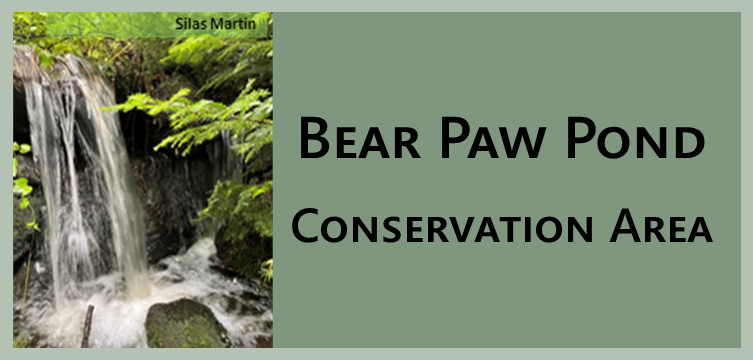
Introduction |
The Bear Paw Pond Conservation Area in the Hazen's Notch area of Montgomery, Vermont is a privately owned nature preserve that is open to the public on a limited basis. The 99-acre property was purchased by the Anderson family in April of 1990. Rolf Anderson will convey a conservation easement on the property to the Hazen's Notch Conservation Trust early in 2026.
Visitor Information / 2024 Trails Map
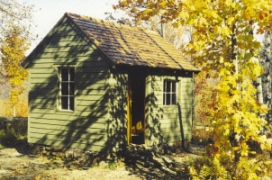
At the entrance to the property along the Hazen's Notch Road is a small grassy clearing surrounded by a wooded glade. Here are perennial flower beds that feature a wide variety of spring-flowering bulbs and mid to late summer blooming plants. Just beyond the Trails Building is Little Rock Pond, home to numerous frogs and salamanders.
There is a small parking area on the right after turning in the one-lane driveway marked 1000 Hazen's Notch Road
. Park here and see the information sign board by the parking lot for current information. Walk up the gravel driveway through the gateposts to reach the trails.
Bear Paw Pond - Aire de Conservation1 Français |
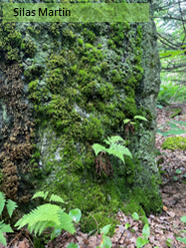
L'aire de conservation Bear Paw Pond est une réserve naturelle privée ouverte au public. Cette terre de 110 acres est située sur le chemin Hazen's Notch Road, dans la municipalité de Montgomery, au Vermont.
Cette propriété fut acquise en Avril 1990 par la famille Anderson dans le but d'y établir le camp d'été Hazen's Notch. Ce camp est une des nombreuses activités proposées par l'Association Hazen's Notch (HNA).
La forêt, peuplée de feuillus et de conifàres, comprend une grande variété de flore et de faune indigàne. Un plan d'aménagement forestier a été réalisé dans le but de restaurer l'habitat faunique et pour assurer la regénération de la forêt.
Un réseau de sentiers offre de nombreuses possibilités pour la marche et l'observation de la nature. Les sentiers sont ouverts de la mi-mai à la mi-novembre. Nous demandons aux visiteurs de respecter les limites de la propriété ainsi que les réglements inscrits sur enseignes du stationnement.
L'aire de conservation Bear Paw Pond comprend une variété d'habitats en terrain montagneux, soit des forêts de feuillus, des forêts mixtes, des forêts de conifères, des cedrières et des prucheraies. Il y a aussi quelques petits prés, ruisseaux et étangs.
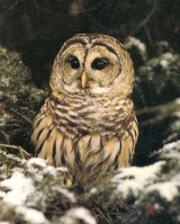
Plusieurs espèces d'oiseaux nichent et se nourrissent dans ces microhabitats. Dans les érablières, on peut y entendre des grives des bois, des grives solitaires et des parulines couronnées de jour, ainsi que des chouettes rayées la nuit. Dans les forêts mixtes matures, on retrouve des tangaras écarlates, des cardinals à poitrine rose, des parulines bleues et des parulines à gorge noire. Les prucheraies sont propices aux troglodytes mignons et aux parulines à gorge orangée. Les endroits ensoleillés attirent les parulines masquées, les chardonnerets jaunes et les moucherolles phébis.
Du mois de mai jusqu'à l'automne, un tapis de fleurs sauvages et de fougéres couvrent le sol. Ce mélange de couleurs et de textures, agrémentés du chant mélodique des oiseaux, feront de chacune de vos randonnées une expérience inoubliable.
En hiver, l'accès aux sentiers se fait à partir de l'Accueil (Welcome Center), situé au 1423 Hazen's Notch Road.
Pour de plus amples informations, veuillez visiter le site web au : www.hazensnotch.org
Natural History2 |
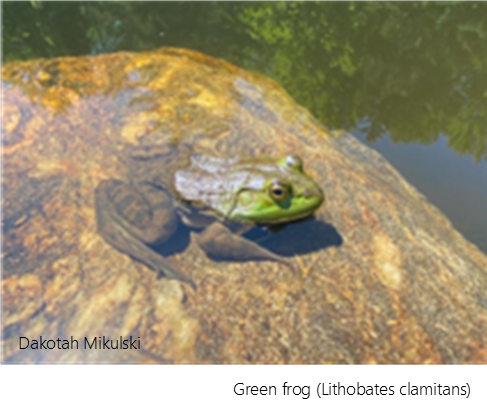
The Bear Paw Pond Area encompasses a sloping forested region with a variety of habitats. - including deciduous woods, mixed deciduous and evergreen woods, northern white cedar woods and hemlock ravines with a few small streams in addition to Bear Paw Pond.
The forest types include deciduous, mixed deciduous and coniferous woods. These woods include the following tree species: sugar maple, red maple, yellow birch, American beech, white ash, American elm, butternut, American basswood and aspen species. Pockets of northern evergreen forest, notably along Spruce Brook, include eastern hemlock, balsam fir, red spruce and white spruce. Other important species commonly associated with the spruce-fir forest type in the Northeast, such as eastern white pine and northern white-cedar, are present.
Many bird species feed and nest here in the many micro-habitats - such as maple woods with Wood Thrush, Hermit Thrush and Ovenbird vocalizing by day and Barred Owl by night; mixed mature woods with Scarlet Tanager, Rose-breasted Grosbeak and Black-throated Blue and Black-throated Green Warblers; and cool hemlock woods with Winter Wren and Blackburnian Warbler. Sunnier areas attract Common Yellowthroat, Chestnut-sided Warbler, American Goldfinch and Eastern Phoebe.
Numerous wildflowers and ferns cloak the ground and add color and form throughout the seasons which, in addition to the birds, create an experience that delights the eyes and ears of a visitor who walks the woodland trails from May through Summer and into Fall.
- Deborah Benjamin
Birds of Open Shrubby Areas |
In areas where full sun conditions exist over low shrubs, young trees, ferns and brambles, there are opportunities to enjoy year-round resident birds and migratory summer birds. Year-round resident birds here include Blue Jay, Black-capped Chickadee, Wild Turkey, and Ruffed Grouse. We can discover their tracks in the snow and hear their contact calling through the crisp air of Fall and Winter. To this backdrop, spring and summer add colorful and songful species such as Indigo Bunting, Chestnut-sided Warbler, Northern Yellowthroat, Gray Catbird, and Song Sparrow.
The abundant sunshine and and ample rainfall make conditions very good for several vegetation types: Cinnamon Fern, Interrupted Fern, Hay-scented Fern and New York Fern; Wild Raspberries and Blackberries and Early Blueberries; and flowering Shrubs such as Spiraea, Chokecherry and viburnums and dogwoods. Wildflowers include goldenrods, asters and a host of summer blooming delights. Many of these plants provide cover, nesting habitat and food for birds. In return, the birds help spread the seeds of some plants by eating the fruits and dropping seeds at random.
With the forest not far away, we can listen for bird species of that habitat: Hermit Thrush, Black-throated Green Warbler, Black-throated Blue Warbler and Ovenbird. On a mild afternoon in early July, while walking the Lower Wood Fern Trail to Wall Street and up to Upper Wood Fern Trail, I had the pleasure of hearing from this open shrubby area beyond the corner stone walls the energetic, loud territorial song of a male Mourning Warbler. This bird is not as common as the other species and always a treat to hear. It is named for the gray-black hood
that covers its head, neck and shoulders. Through its song, the bird spoke of this habitat as perfect for its preferred nesting site; and the habitat welcomed this species with open leaves, branches, food and cover.
- Deborah Benjamin
Conservation Values / Conservation Stewardship |
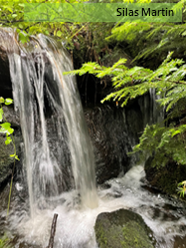
The Anderson family set out to preserve a woodland that supports important natural communities and associated species. Their goal is to maintain an ecologically functional landscape through responsible stewardship, which is intended to preserve plant communities and a diversity of habitats. The Bear Paw Pond Conservation Area lies within an area designated by the Vermont Department of Fish and Wildlife as a highest priority, interior forest block for conservation. This nature preserve has strong natural resource values which support native plant communities, biodiversity, wildlife habitat, wildlife corridor, structural and functional connectivity, numerous woodland seeps, vernal pools, and two streams which rise on the property.
Professional foresters and naturalists have made detailed inventories and assessments of the flora and fauna present. Numerous areas with rich forest soils and mature trees provide ideal conditions for woodland plants. The Stewardship Management Plan emphasizes biological diversity and forest health, protection of soils, wetlands, and riparian areas, protection of habitat for interior forest birds and mammals, protecting corridor connectivity with adjacent conservation lands. and maintenance of an adjacent old field / shrub habitat to support migratory birds and pollinators. Audubon Society guidelines for improving conditions for forest birds have been incorporated into the Stewardship management plan. The largest live elm in a forest setting in Franklin County grew in a portion of the property where rich soils support some very large and healthy trees to this day.
Visitor Information |
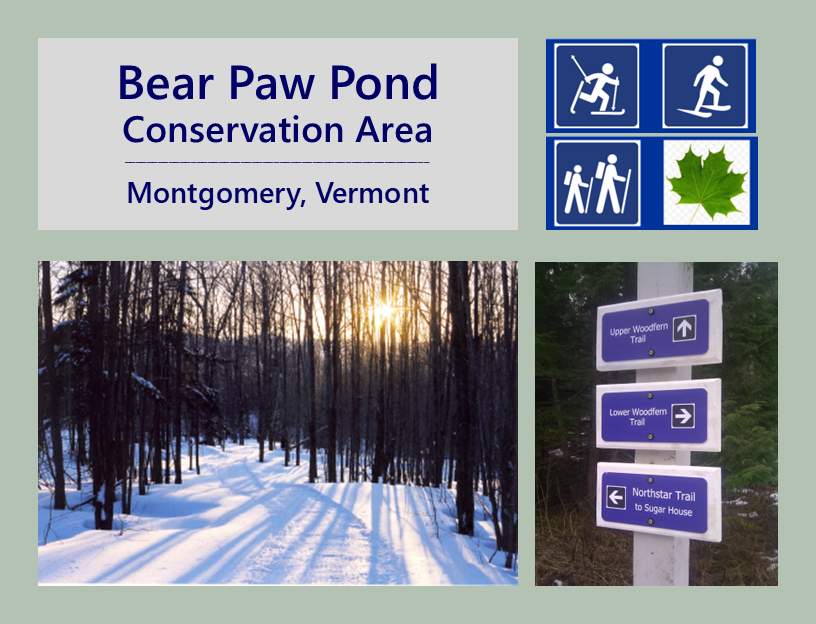
A network of trails provides opportunities for walking and nature observation in spring, summer and fall and cross-country skiing and snowshoeing in winter.

In winter, trail access is from the Hazen's Notch Welcome Center at 1423 Hazen's Notch Road. Starting at the Welcome Center, the Woodfern Trail leads on a gradual, uphill traverse to Coyote Meadow, to Woodfern Loop and other trails on the Bear Paw Pond Conservation Area. Please observe all signs posted at the parking area and at property boundaries.

Visitors may park in the parking area at the entrance to the property or, especially in Winter, at the Hazen's Notch Welcome Center. Fishing, Swimming, Fires, Camping, Motorized Vehicles & Bicycles are not allowed. Dogs must be on leash at all times but are not allowed in Winter. Trails are closed to everyone during Spring mud season, from April 1 to May 21. Although hunting is not allowed, hikers should limit their outings to walking local roads during hunting season and spring mud season. The entire area closes at sunset.
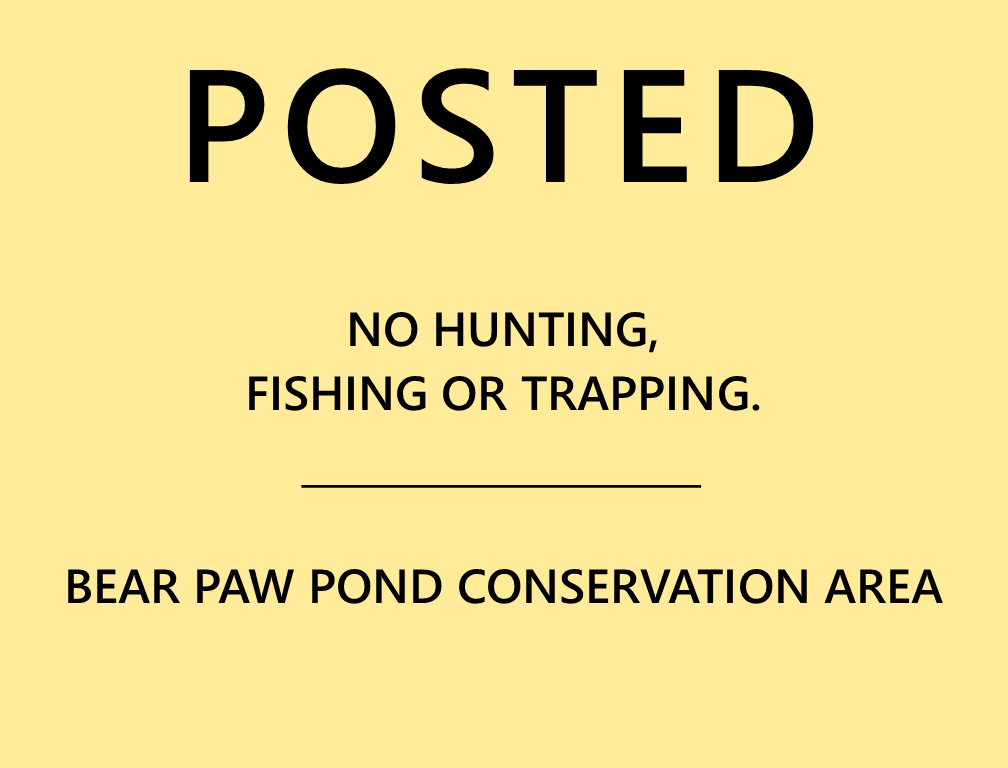
Please respect this private property and help to ensure continued access. For complete visitor information, see the website of the Hazen's Notch Association: www.hazensnotch.org
History of the Bear Paw Pond Conservation Area |
The land was part of the Curt Hart farm during the middle of the 20th century and was open land - pasture - up as far as where Bear Paw Pond is today. The original Curt Hart Farm was a little more than 200 acres in size. Mr. Hart sold his land in 19?? to a New York City couple who lived in the house that is just after the end of the paved portion of the Hazen's Notch Road.
Cows were last grazed here in the 1960's by a neighboring farmer. The area uphill from Bear Paw Pond was always mostly forested. There are numerous old sugar maples, many sap collecting pails scattered about, and the remains of an old sugar house in the western part of the property that had been a sugar bush. From the entrance to the property up to Bear Paw Pond, the young forest has mostly red maple trees that have grown since the end of Curt Hart's ownership.
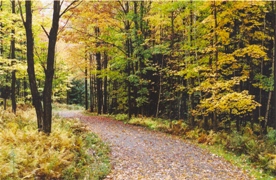
The benign ownership of the New York City native ended when the New Yorker sold the former Curt Hart Farm (200+ acres) to a local real estate developer. The local developer partially subdivided the property by creating three 4.5-acre lots and numerous 10-acre lots.
At the point that the Anderson Family started discussions with the developer, there was one 4.5-acre lot and 94 undivided acres remaining. The developer intended to create 10-acre house lots from the 94-acre parcel. The old tractor path leading uphill into the parcel would have become a two-way access road for the housing development.
The Anderson Family purchased the two parcels in 1990 to prevent further subdivision. Ten years later they purchased an adjoining undeveloped 10-acre lot from one of the people who bought a subdivided parcel in the late 1980's. Currently the Bear Paw Pond Conservation Area is 110 acres in size. The old tractor path is now an improved woods road that is used by the landowner to access Bear Paw Pond and by the public for walking, snowshoeing and cross-country skiing. The access road is not plowed in winter.
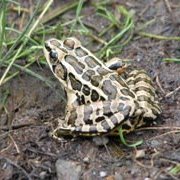
The Anderson family began by consulting with James Tessman, Franklin-Grand Isle County Forester. Mr. Tessman visited and discussed plans to repair skid trails and wood roads damaged from light logging done by the previous owner. Discussions included developing a forest management plan and the creation of an environmental education camp for children. We are grateful to James Tessman for his advice, support and strong encouragement. Roger Sternberg, a professional consulting forester, was hired to develop a Forest Management Plan. The Andersons knew Roger Sternberg from their work on the Green Mountain Club's Land Protection Committee. The Andersons spent 4 years working with Marty Lumbra who restored the skid trails, woods roads and built Bear Paw Pond; with Robert B. Anderson (no relation), Kevin Conneely, and Jerry Mayhew who constructed the small buildings associated with the environmental education programs; and Charles Fichman, stone mason, who built stone walls. Deborah Benjamin made inventories of the native plants and of the breeding birds present on the property. The survey of breeding birds occurred during the second Vermont Breeding Bird Atlas survey which took place during 2003, 2004 and 2005.
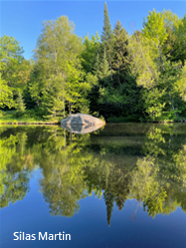
This 99-acre portion of the former Curt Hart Farm
has been protected from subdivision. The forest has been protected from fragmentation. The Stewardship Management Plan emphasizes biological diversity and forest health. Audubon Society guidelines for improving conditions for forest birds have been incorporated into the Stewardship management plan.
A small area has been lightly developed to create a summer camp for children with an emphasis on environmental education and outdoor skills. Many people enjoy walking, cross country skiing and snowshoeing within the Bear Paw Pond Conservation Area and as they pass through on the network of trails that are managed by the Hazen's Notch Association. Please observe the rules mentioned here and posted at the property.
Rolf Anderson will convey a conservation easement on the property to the Hazen's Notch Conservation Trust early in 2026.
Hazen's Notch Conservation Trust |
The Hazen's Notch Conservation Trust was formed to conserve wildlife habitats, soil and water resources, undeveloped open space and natural areas, and non-motorized recreational trails. HNCT works with interested landowners to explore outdoor recreation opportunities compatible with their property and land management philosophy. A priority for the HNCT is to conserve parcels adjacent to existing conserved lands in order to expand protection of wildlife corridors and habitats.
Website: Hazen's Notch Conservation Trust, Inc.
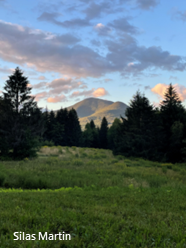
References
Bear Paw Pond - Aire de Conservation.
Natural History of the Bear Paw Pond Conservation Area,
Birds of Open Shrubby Areas.
Bibliography
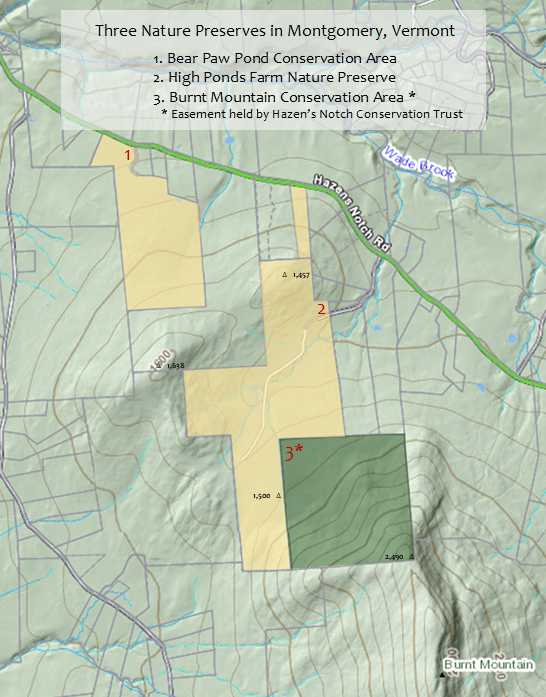
People, Land, and Community, essay in: Standing by Words. New York: Farrar, Strauss and Giroux, Inc. 1983
Changes in the Land - Indians, Colonists and the Ecology of New England. New York: Farrar, Strauss and Giroux, Inc. 1983
Mother of All: An Introduction to Bioregionalism. New Haven: Yale University Press. 1997